
Common sense and good driving habits will afford maximum tire life. Fast starts, sudden stops and hard cornering are hard on tires and will shorten their useful life span. Make sure that you don't overload the vehicle or run with incorrect pressure in the tires. Both of these practices will increase tread wear.
For optimum tire life, keep the tires properly inflated, rotate them often and have the wheel alignment checked periodically.
Inspect your tires frequently. Be especially careful to watch for bubbles in the tread or sidewall, deep cuts or underinflation. Replace any tires with bubbles in the sidewall. If cuts are so deep that they penetrate to the cords, discard the tire. Any cut in the sidewall of a radial tire renders it unsafe. Also look for uneven tread wear patterns that may indicate the front end is out of alignment or that the tires are out of balance.
TIRE ROTATION
See Figures 1, 2 and 3
Tires must be rotated periodically to equalize wear patterns that vary with a tire's position on the vehicle. Tires will also wear in an uneven way as the front steering/suspension system wears to the point where the alignment should be reset.
Rotating the tires will ensure maximum life for the tires as a set, so you will not have to discard a tire early due to wear on only part of the tread. Regular rotation is required to equalize wear.
When rotating "unidirectional tires,'' make sure that they always roll in the same direction. This means that a tire used on the left side of the vehicle must not be switched to the right side and vice-versa. Such tires should only be rotated front-to-rear or rear-to-front, while always remaining on the same side of the vehicle. These tires are marked on the sidewall as to the direction of rotation; observe the marks when reinstalling the tire(s).
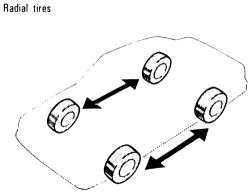
 |  |
Fig. Fig. 1: Toyota tire rotation recommendation-1988-95 models
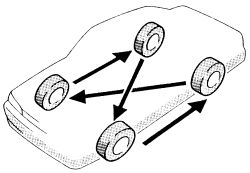
 |  |
Fig. Fig. 2: Toyota tire rotation recommendation-1996-97 models
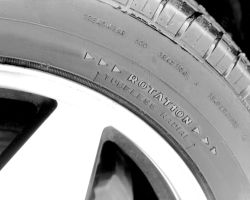
 |  |
Fig. Fig. 3: Unidirectional tires are identifiable by sidewall arrows and/or the word "rotation''
Some styled or "mag'' wheels may have different offsets front to rear. In these cases, the rear wheels must not be used up front and vice-versa. Furthermore, if these wheels are equipped with unidirectional tires, they cannot be rotated unless the tire is remounted for the proper direction of rotation.
The compact or space-saver spare is strictly for emergency use. It must never be included in the tire rotation or placed on the vehicle for everyday use.
TIRE DESIGN
See Figure 4
For maximum satisfaction, tires should be used in sets of four. Mixing of different types (radial, bias-belted, fiberglass belted) must be avoided. In most cases, the vehicle manufacturer has designated a type of tire on which the vehicle will perform best. Your first choice when replacing tires should be to use the same type of tire that the manufacturer recommends.
When radial tires are used, tire sizes and wheel diameters should be selected to maintain ground clearance and tire load capacity equivalent to the original specified tire. Radial tires should always be used in sets of four.
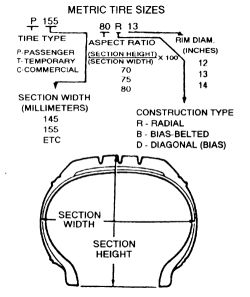
 |  |
Fig. Fig. 4: P-Metric tire coding
When selecting tires, pay attention to the original size as marked on the tire. Most tires are described using an industry size code sometimes referred to as P-Metric. This allows the exact identification of the tire specifications, regardless of the manufacturer. If selecting a different tire size or brand, remember to check the installed tire for any sign of interference with the body or suspension while the vehicle is stopping, turning sharply or heavily loaded.
Snow TiresGood radial tires can produce a big advantage in slippery weather, but in snow, a street radial tire does not have sufficient tread to provide traction and control. The small grooves of a street tire quickly pack with snow and the tire behaves like a billiard ball on a marble floor. The more open, chunky tread of a snow tire will self-clean as the tire turns, providing much better grip on snowy surfaces.
To satisfy municipalities requiring snow tires during weather emergencies, most snow tires carry either an M + S designation after the tire size stamped on the sidewall, or the designation "all-season.'' In general, no change in tire size is necessary when buying snow tires.
Most manufacturers strongly recommend the use of 4 snow tires on their vehicles for reasons of stability. If snow tires are fitted only to the drive wheels, the opposite end of the vehicle may become very unstable when braking or turning on slippery surfaces. This instability can lead to unpleasant endings if the driver can't counteract the slide in time.
Note that snow tires, whether 2 or 4, will affect vehicle handling in all non-snow situations. The stiffer, heavier snow tires will noticeably change the turning and braking characteristics of the vehicle. Once the snow tires are installed, you must re-learn the behavior of the vehicle and drive accordingly.
Consider buying extra wheels on which to mount the snow tires. Once done, the "snow wheels'' can be installed and removed as needed. This eliminates the potential damage to tires or wheels from seasonal removal and installation. Even if your vehicle has styled wheels, see if inexpensive steel wheels are available. Although the look of the vehicle will change, the expensive wheels will be protected from salt, curb hits and pothole damage.
TIRE STORAGE
If they are mounted on wheels, store the tires at proper inflation pressure. All tires should be kept in a cool, dry place. If they are stored in the garage or basement, do not let them stand on a concrete floor; set them on strips of wood, a mat or a large stack of newspaper. Keeping them away from direct moisture is of paramount importance. Tires should not be stored upright, but in a flat position.
INFLATION & INSPECTION
See Figures 5 through 12
The importance of proper tire inflation cannot be overemphasized. A tire employs air as part of its structure. It is designed around the supporting strength of the air at a specified pressure. For this reason, improper inflation drastically reduces the tire's ability to perform as intended. A tire will lose some air in day-to-day use; having to add a few pounds of air periodically is not necessarily a sign of a leaking tire.
Two items should be a permanent fixture in every glove compartment: an accurate tire pressure gauge and a tread depth gauge. Check the tire pressure (including the spare) regularly with a pocket type gauge. Too often, the gauge on the end of the air hose at your corner garage is not accurate because it suffers too much abuse. Always check tire pressure when the tires are cold, as pressure increases with temperature. If you must move the vehicle to check the tire inflation, do not drive more than a mile before checking. A cold tire is generally one that has not been driven for more than three hours.

 |  |
Fig. Fig. 5: Tires should be checked frequently for any sign of puncture or damage
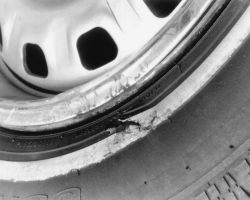
 |  |
Fig. Fig. 6: Tires with deep cuts, or cuts which show bulging should be replaced immediately
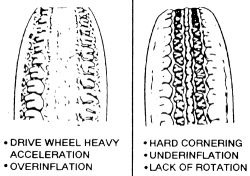
 |  |
Fig. Fig. 7: Examples of inflation-related tire wear patterns

 |  |
Fig. Fig. 8: Radial tires have a characteristic sidewall bulge; don't try to measure pressure by looking at the tire. Use a quality air pressure gauge
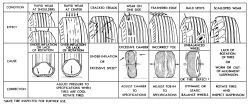
 |  |
Fig. Fig. 9: Common tire wear patterns and causes
A plate or sticker is normally provided somewhere in the vehicle (door post, hood, tailgate or trunk lid)
which shows the proper pressure for the tires. Never counteract excessive pressure build-up by bleeding off air pressure (letting some air out). This will cause the tire to run hotter and wear quicker.
Once you've maintained the correct tire pressures for several weeks, you'll be familiar with the vehicle's braking and handling personality. Slight adjustments in tire pressures can fine-tune these characteristics, but never change the cold pressure specification by more than 2 psi. A slightly softer tire pressure will give a softer ride but also yield lower fuel mileage. A slightly harder tire will give crisper dry road handling but can cause skidding on wet surfaces. Unless you're fully attuned to the vehicle, stick to the recommended inflation pressures.
All tires made since 1968 have built-in tread wear indicator bars that show up as 1/2 in. (13mm) wide smooth bands across the tire when 1/16 in. (1.5mm) of tread remains. The appearance of tread wear indicators means that the tires should be replaced. In fact, many states have laws prohibiting the use of tires with less than this amount of tread.
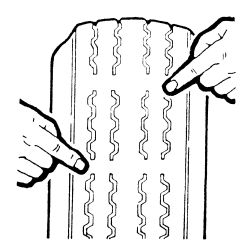
 |  |
Fig. Fig. 10: Tread wear indicators will appear when the tire is worn
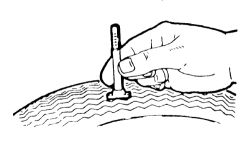
 |  |
Fig. Fig. 11: Accurate tread depth indicators are inexpensive and handy
You can check your own tread depth with an inexpensive gauge or by using a Lincoln head penny. Slip the Lincoln penny (with Lincoln's head upside-down) into several tread grooves. If you can see the top of Lincoln's head in 2 adjacent grooves, the tire has less than 1/16 in. (1.5mm) tread left and should be replaced. You can measure snow tires in the same manner by using the "tails'' side of the Lincoln penny. If you can see the top of the Lincoln memorial, it's time to replace the snow tire(s).
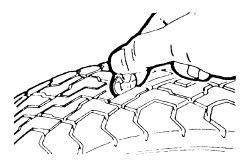
 |  |
Fig. Fig. 12: A penny works well for a quick check of tread depth
CARE OF SPECIAL WHEELS
If you have invested money in magnesium, aluminum alloy or sport wheels, special precautions should be taken to make sure your investment is not wasted and that your special wheels look good for the life of the vehicle.
Special wheels are easily damaged and/or scratched. Occasionally check the rims for cracking, impact damage or air leaks. If any of these are found, replace the wheel. But in order to prevent this type of damage and the costly replacement of a special wheel, observe the following precautions: